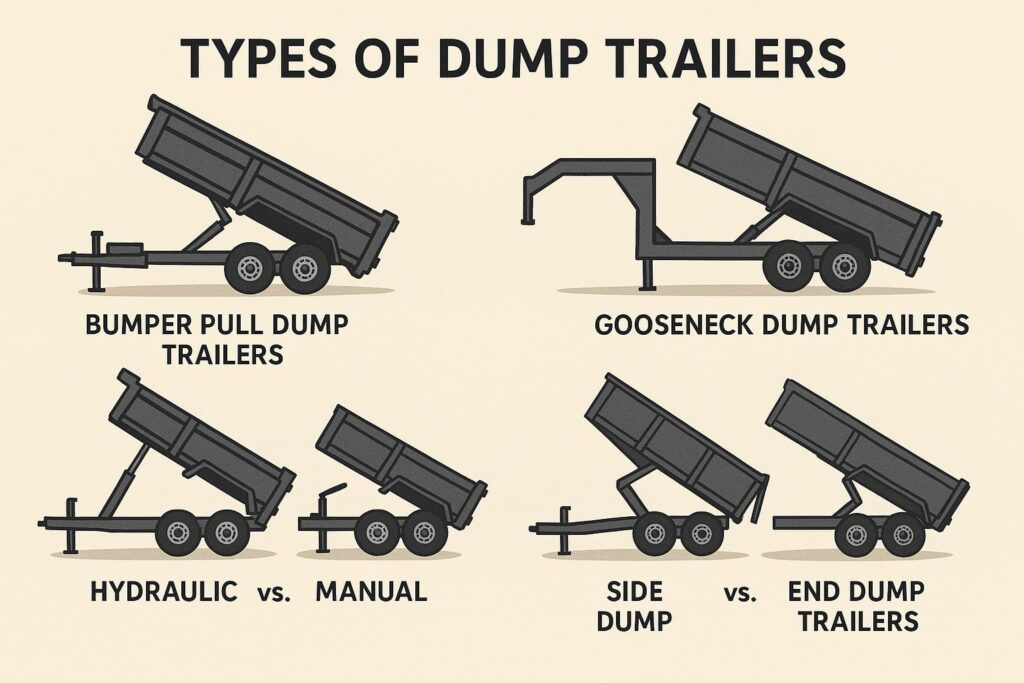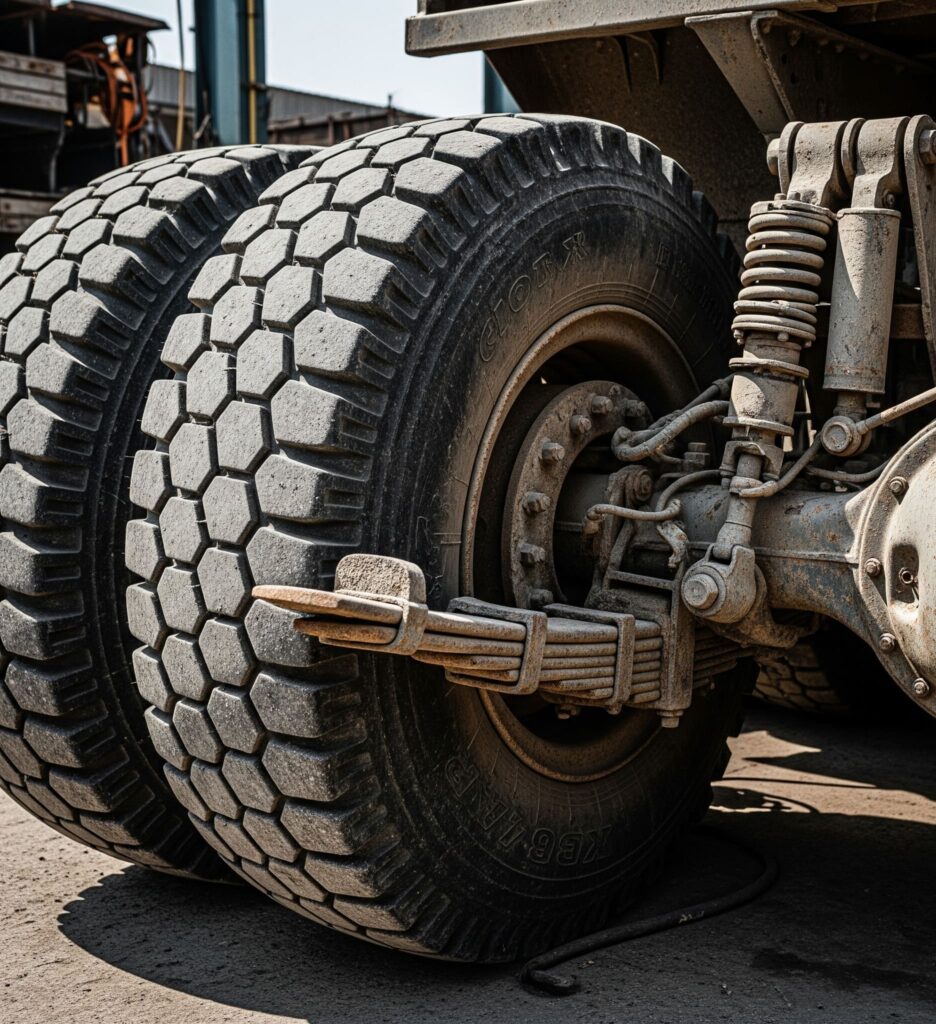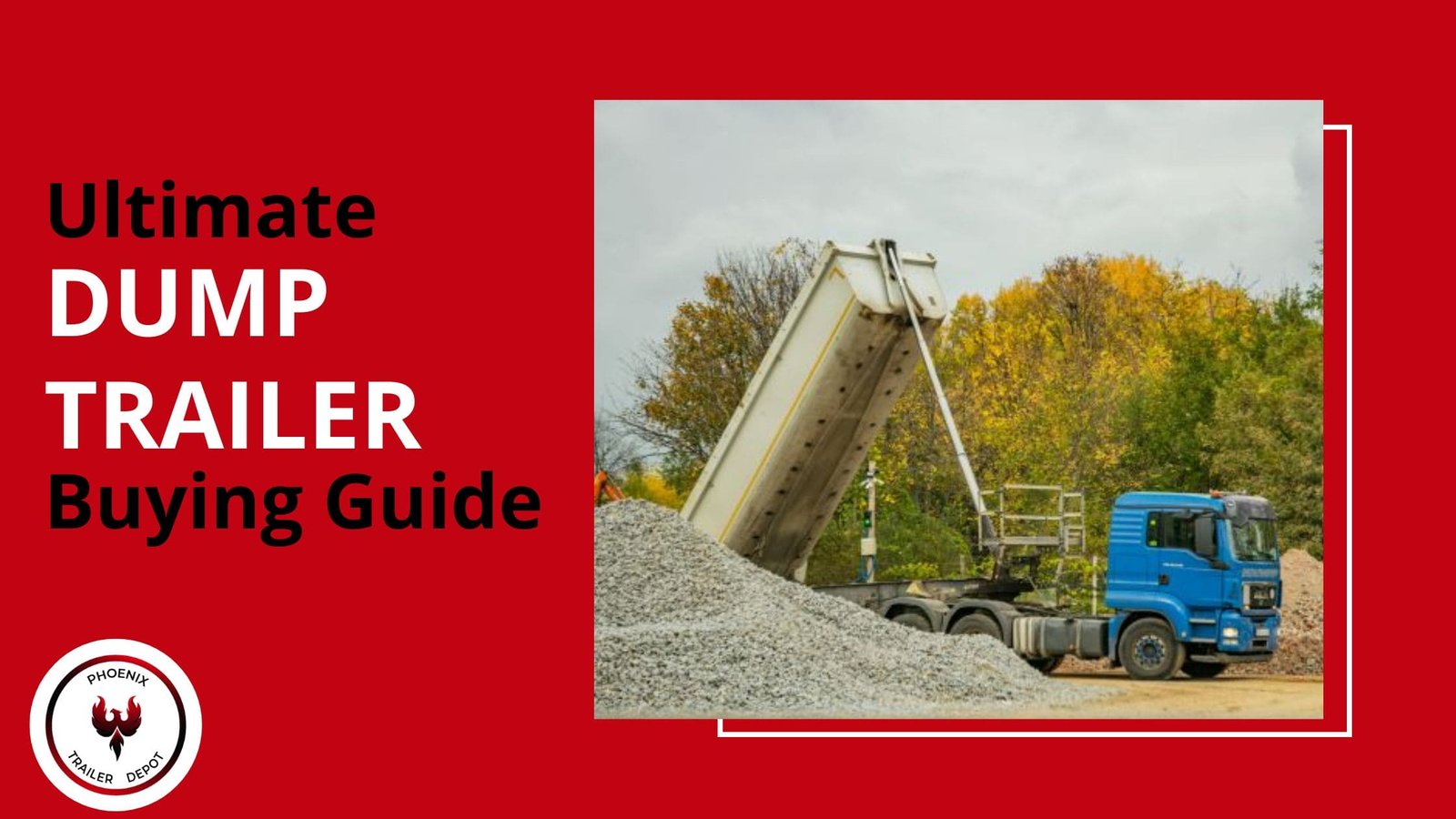Whether you’re a contractor, farmer, landscaper, or just someone who loves working on heavy-duty DIY projects, choosing the right dump trailer can make your job much easier. But with so many types, sizes, and weight ratings to consider, it can get overwhelming fast.
That’s where this dump trailer buying guide comes in.
We’ll walk you through everything you need to know before buying — including what a dump trailer is, why you might need one, and how to pick the best type and size for your work. This guide is designed to help beginners and seasoned haulers alike make smart, informed decisions that save time, money, and headaches down the line.
What Is a Dump Trailer?
A dump trailer is a type of utility trailer designed specifically to carry and unload bulk materials like gravel, sand, debris, mulch, or equipment. It comes with a hydraulic or manual lift system that tilts the bed, allowing the contents to slide or dump out easily.
Unlike a standard utility trailer, a dump trailer is made for heavy-duty hauling. It’s perfect for people in construction, agriculture, landscaping, or large-scale cleanups. Some models are equipped with double or triple axles, steel sidewalls, and electric brakes to safely manage heavier loads.
There are several components that make up a dump trailer:
- Trailer bed: Where the load sits. It’s typically made from steel or aluminum.
- Hydraulic lift: Powers the dumping action, usually through a remote or in-bed control.
- Axles and tires: Support the weight and help distribute it evenly.
- Tailgate: Opens to let the load fall out; some swing open while others drop down.
- Battery box and pump: Found in hydraulic models for powering the lift.
If you’re wondering why a dump trailer matters, think of it this way: it’s like having an extra pair of strong hands that never get tired — and it saves your back, too.
Why Choose a Dump Trailer?
There are several advantages to choosing a dump trailer over other types of hauling equipment. Let’s break it down:
1. Saves Time and Labor
Manually unloading materials from a truck bed or flat trailer can be back-breaking work. A dump trailer handles this with a hydraulic lift system that makes unloading quick and nearly effortless.
2. Built for Versatility
One of the biggest reasons people search for a dump trailer buying guide is because they need a solution that works in multiple scenarios. Whether you’re transporting firewood to a campsite, hauling away roofing shingles, or moving gravel for a driveway, dump trailers can do it all.
3. Hauls Heavy Loads
Dump trailers are designed for heavy-duty performance. Depending on the model and axle configuration, you can haul several tons of material — all while maintaining stability and control.
4. Tows Easily with Most Trucks
Whether you have a half-ton pickup or a full-size diesel, there’s a dump trailer that will fit your towing specs. This compatibility is key, especially for contractors or homeowners who don’t want to upgrade their truck just to move dirt.
5. Safer and Cleaner Job Sites
Instead of piling debris or loose material in the back of a pickup truck — risking spillage or unsafe loads — a dump trailer keeps everything enclosed. This minimizes accidents and helps keep job sites clean.
Types of Dump Trailers
When you’re shopping for a trailer, understanding the different types of dump trailers is crucial. Not every trailer is built the same, and each type is made to handle specific jobs, loads, and terrain. The right one can save you time, reduce stress on your vehicle, and prevent unnecessary wear and tear.

Let’s look at the most common dump trailer types in detail:
1. Bumper Pull Dump Trailers
Bumper pull trailers are the most popular and widely used option for everyday hauling. They attach directly to a hitch on the back of your vehicle — usually a standard ball mount. This makes them ideal for casual or light-duty users who still need to haul gravel, firewood, or remodeling debris.
Benefits:
- Easier to hook up and tow for beginners
- Compatible with most half-ton and three-quarter-ton trucks
- Less expensive than gooseneck models
- Great for tight urban or residential jobsites
This trailer style is perfect if you’re just starting out or if you don’t need to haul huge loads every day. For example, landscapers and homeowners often lean toward bumper pull models for their mix of size, simplicity, and affordability.
2. Gooseneck Dump Trailers
If you’re hauling larger or heavier loads — or doing long-distance driving — a gooseneck dump trailer is worth serious consideration.
Instead of connecting to your bumper, a gooseneck trailer connects to a hitch mounted in the bed of your truck. This design places the weight directly over the rear axle, giving you better balance and control.
Benefits:
- Better weight distribution
- Increased towing stability, especially at high speeds
- Higher payload capacities
- Ideal for commercial-grade hauling or construction sites
While they do cost more upfront, gooseneck trailers are the go-to option for professionals who need serious power and don’t want to sacrifice safety or efficiency.
3. Hydraulic vs. Manual Dump Trailers
One of the most important decisions when buying a dump trailer is how it will unload its contents. That’s where hydraulic and manual lift systems come into play.
a. Hydraulic Dump Trailers:
These use a hydraulic pump system powered by a battery to raise the trailer bed. They’re quick, efficient, and especially helpful when handling heavy or sticky loads like wet dirt or clay.
b. Manual Dump Trailers:
These require you to use physical force or a crank to lift the bed. While they’re cheaper, they’re best for light-duty jobs and infrequent use.
Tip: If you plan to use your trailer regularly, a hydraulic system is well worth the investment — both for your safety and your time.
4. Side Dump vs. End Dump Trailers
How your trailer dumps can also make a big difference, depending on the job site and the kind of material you’re hauling.
a. End Dump Trailers:
These are the standard designs. The front of the bed lifts and the load slides out the back. They’re simple and reliable for general use like hauling mulch, roofing debris, or gravel.
b. Side Dump Trailers:
These tip to the side instead of the rear. They’re ideal for jobs with tight access or where dumping from the rear isn’t safe — like along roadsides or inside narrow lots.
Choosing between these two styles depends on your unloading conditions. If you need flexibility and work in cramped spaces, a side dump is a smart option.
Dump Trailer Sizes Explained
Size matters — especially when you’re hauling thousands of pounds of material. Choosing the wrong size trailer can lead to overloads, unsafe towing, and higher fuel costs. That’s why a good dump trailer buying guide always includes a breakdown of size options.
Here’s what you need to know:
1. Small Dump Trailers (5×8, 6×10)
These compact trailers are great for homeowners and DIYers who don’t need massive hauling power. They can handle basic yard work, furniture disposal, or small renovation waste.
Best for:
- Mulch, dirt, or gravel for landscaping
- Light home remodeling debris
- Small lawn care equipment
Their smaller footprint makes them perfect for tight residential driveways or storage areas.
2. Medium Dump Trailers (6×12, 7×14)
This is the most popular size range for small business owners, landscapers, and general contractors. Medium-sized trailers offer a balance between capacity and maneuverability.
Best for:
- Roofing jobs
- Hauling bulk mulch or gravel
- Small construction equipment
With a little more space and higher weight ratings, these are considered the sweet spot for part-time or full-time use.
3. Large Dump Trailers (7×16 and above)
Need to move tons of material in fewer trips? Then you’re looking for a large dump trailer. These heavy-duty models are designed for commercial operations and tough, all-day jobs.
Best for:
- Demolition cleanup
- Full-site excavation
- Equipment transport
They often come with dual axles, reinforced frames, and high sides — allowing them to carry loads safely without spillage or structural stress.
Understanding Dump Trailer Weight Capacity
When it comes to trailers, capacity isn’t just about space — it’s also about how much weight the trailer can safely carry and how well your vehicle can tow it. This is where many buyers get tripped up.
In this part of our dump trailer buying guide, we’ll break down three key weight terms that every trailer owner should understand
1. GVWR (Gross Vehicle Weight Rating)
GVWR stands for Gross Vehicle Weight Rating. It’s the maximum total weight your trailer can safely handle, including the weight of the trailer itself and the load inside.
For example, if a trailer has a GVWR of 10,000 pounds and the trailer itself weighs 3,000 pounds, that means you can haul up to 7,000 pounds of cargo.
Why it matters:
Exceeding the GVWR can cause mechanical failure, increase the risk of accidents, and even result in fines.
2. Payload Capacity
Payload capacity is the actual amount of material you can put into the trailer. It’s calculated by subtracting the trailer’s empty weight (also called curb weight) from its GVWR.
- Formula:
GVWR – Trailer Weight = Payload Capacity
Choosing the right payload capacity ensures you don’t overload your trailer or strain your towing vehicle.
3. Tongue Weight Considerations
Tongue weight is the amount of the trailer’s weight that presses down on the hitch of your towing vehicle. It’s usually about 10–15% of the total trailer weight when loaded.
Why it matters:
- Too much tongue weight can lift your front tires and reduce steering control.
- Too little can cause the trailer to sway dangerously.
Always check your truck’s towing guide and the trailer’s specifications to ensure you’re towing within safe limits.
Reminder: Matching your towing vehicle to your trailer is just as important as choosing the right trailer. If the load’s too heavy for your truck, you’re risking damage to both — and putting safety on the line.
How to Choose the Right Dump Trailer for Your Needs?
Choosing the right dump trailer isn’t just about picking the biggest or most expensive model. It’s about matching the trailer to your real-world needs — what you haul, how often, and with what kind of vehicle. This is one of the most important parts of any dump trailer buying guide.
Let’s break it down into the key factors.
1. Type of Load
Think about what you’ll be hauling most often. Are you moving loose material like gravel or mulch? Heavy debris like concrete? Or equipment like skid steers?
Different loads call for different features:
- Loose material: Consider trailers with high sides to prevent spillage.
- Heavy material: You’ll need a higher payload capacity and reinforced frame.
- Machinery: Look for ramp options and adequate bed size for loading and unloading.
2. Towing Vehicle Compatibility
You can’t just buy a trailer and hope your truck can handle it. Always check your truck’s towing capacity, which includes both gross trailer weight and tongue weight.
Ask yourself:
- Does my truck support a gooseneck or bumper pull hitch?
- Can it handle the trailer’s GVWR safely?
- Will it need upgraded brakes or a weight distribution hitch?
A mismatch between trailer and tow vehicle is a leading cause of road accidents. Stay safe by consulting your vehicle’s manual or using online towing calculators.
3. Frequency of Use
A trailer used daily on a job site needs to be more durable and better equipped than one used a few weekends a year.
Occasional Use:
- Smaller size
- Manual lift may be acceptable
- Single axle is usually enough
Frequent Use:
- Hydraulic lift is a must
- Dual axles for better load distribution
- Sturdier materials and longer warranty
If you’re unsure, it’s always better to buy slightly more trailers than you think you need. You’ll grow into it — and save yourself from a costly upgrade later.
Key Features to Look For
Not all dump trailers are created equal. The right features can improve safety, performance, and ease of use, especially if you’re hauling materials regularly.
In this part of the dump trailer buying guide, we’ll look at the most important features to consider.
1. Frame and Build Quality
The frame is the foundation of your trailer. A weak or poorly welded frame can lead to bending, rust, or failure under stress.
Look for:
- Tubular steel construction for strength
- Powder-coated finish to resist rust
- Reinforced cross-members for added stability
2. Ramp and Gate Options
Your dump trailer should help you unload as easily as it loads. The type of rear gate matters — a lot.
Common types:
- Spreader gate: Great for materials like gravel, as it opens from the bottom.
- Barn doors: Swing open wide for easy equipment access.
- Combo gates: Offer the flexibility of both options.
Ramps are essential if you plan on loading equipment like mowers, ATVs, or compact tractors.
3. Tires and Axles
Your tires and axles take the brunt of the load, so don’t skimp here.
Consider:
- Tandem axles (two sets) for better stability and higher weight capacity
- Radial tires for better road handling and durability
- Electric brakes on each axle for better stopping power
Overloaded or under-inflated tires can blow out on the road, causing serious accidents or damage to your cargo.

4. Lifting Mechanism
The trailer’s lifting system is what turns it from a basic hauler into a powerful dumping tool.
Look for:
- Hydraulic lifts (scissor or telescoping) with power-up and power-down features
- Battery-powered systems with easy remote controls
- Protective housing to guard the pump from weather and damage
If you’re lifting heavy materials, go hydraulic — manual lifts won’t cut it after a few loads.
Common Mistakes to Avoid When Buying a Dump Trailer
Even experienced buyers make mistakes when shopping for trailers. Let’s go over some of the most common errors people make — and how to avoid them.
1. Underestimating Load Needs
Many first-time buyers pick a trailer that’s too small or light. It might be fine at first, but as your projects grow, the trailer won’t keep up.
Solution: Go a little bigger than you think you’ll need. It’s easier to carry less than it is to carry more than you’re rated for.
2. Ignoring Towing Vehicle Limits
Buying a heavy-duty trailer when your truck can’t tow it is a costly and dangerous mistake.
Solution: Always check your vehicle’s maximum towing specs — including tongue weight, payload, and GCWR (Gross Combined Weight Rating).
3. Choosing the Cheapest Option
It’s tempting to go for the lowest price, especially if you’re on a tight budget. But cheap trailers often lack durability, proper safety features, or decent warranties.
Solution: Focus on value over price. A well-built trailer might cost more upfront, but it’ll last longer and cost less in repairs.
4. Overlooking Legal Requirements
Some states require DOT lighting, reflective tape, breakaway kits, or specific brake systems for trailers over a certain weight.
Solution: Check your local DMV or Department of Transportation website for trailer laws and registration requirements.
Conclusion
Buying a dump trailer isn’t just about picking what looks good on a dealer lot. It’s about finding the right fit for your needs — your load type, your truck, and your work habits.
This dump trailer buying guide has walked you through:
- The most common trailer types (bumper pull, gooseneck, hydraulic vs. manual)
- How to choose the right size and weight capacity
- The most useful features to look for
- Mistakes to avoid so you don’t waste your money or compromise safety
Whether you’re purchasing your first trailer or upgrading to a better one, doing some research now can help you avoid costly mistakes later. At Phoenix Trailer Depot LLC, we’re here to make the process easy and stress-free—explore our trailer options today and get expert guidance you can trust!
FAQs About Dump Trailers
Even after reading a full dump trailer buying guide, a few questions still pop up. Here are four of the most important ones to help you feel confident before buying.
1. Can I tow a dump trailer with a half-ton truck?
Yes — but with limits. A half-ton truck like an F-150 or Ram 1500 can safely tow smaller dump trailers, such as 5×8 or 6×10 models, depending on the trailer’s weight and load.
Check your truck’s towing capacity and compare it with the trailer’s GVWR (Gross Vehicle Weight Rating).
Make sure your truck has a trailer brake controller for safety.
2. How much weight can a dump trailer haul?
It depends on the payload capacity, which you calculate by subtracting the trailer’s empty weight from its GVWR.
For example:
GVWR = 10,000 lbs
Trailer weight = 3,000 lbs
Payload = 7,000 lbs
3. Should I buy new or used?
It depends on your needs and budget.
A. Buy new if you want:
– A warranty
– The latest features
– No hidden wear or damage
B. Buy used if you want:
– Lower upfront cost
– Basic hauling needs
– You’re comfortable with maintenance
4. What kind of maintenance does a dump trailer need?
Regular care keeps your trailer in top shape and prevents breakdowns.
– Check tires and brakes before every trip
– Grease axles and bearings at least once a year
– Inspect the hydraulic system for leaks or low fluid
– Clean the bed after each use to prevent rust





Leave a Reply